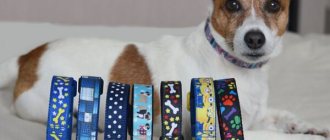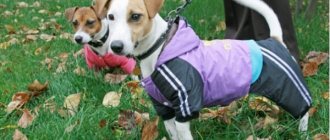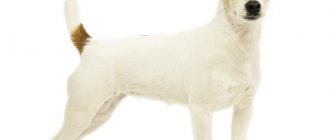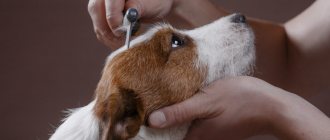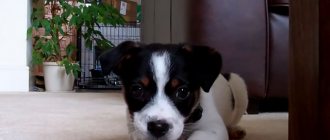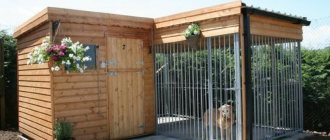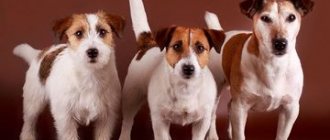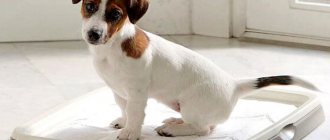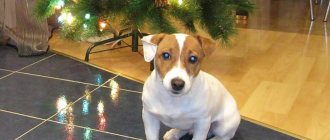A distinctive feature of the Jack Russell Terrier breed is its mobility.
The breed was created for the needs of hunters. And although now, Jacks are kept mainly as pets, their hunting instincts have not disappeared and make themselves felt: these dogs need constant physical activity and walks.
Some people think that clothing for a Jack Russell Terrier is a whim, a desire to draw attention to yourself and your pet.
But for small dogs, walking clothes often become necessary.
There are two varieties of this breed: long-haired and smooth-haired. Long hair to some extent performs heating functions. But for dogs with short hair, it becomes difficult in severe frosts or in the chilly wind. Clothes for dogs are needed to make the animal comfortable while walking .
How to choose
First you need to take all measurements from your pet. The suit itself should be made of durable and waterproof material to protect the dog from getting wet. A winter outfit should have a warm lining inside to protect against the cold. Most often it is made from fleece. And the outer part is made of nylon.
The suit should not have crooked seams or protruding threads. And even more so it should not be defective. The Jack Russell Terrier is an active dog that loves to run and jump regardless of the time of year. And the pet should feel comfortable in a suit, and not vice versa.
Choosing a Collar
There are certain rules, subject to which your pet will feel comfortable in a collar:
- two fingers of your hand should fit freely between the dog’s neck and the collar;
- the collar should be so wide that it cannot be removed over the head;
- The collar should not restrict movement or put pressure. The dog should turn and tilt its head freely;
- The collar should be made of a material that does not chafe the skin. Check the material, feel it, is it soft enough?
IMPORTANT!
It is advisable to choose a collar, like a harness, by trying it on the dog. This way you can better assess whether the accessory hinders your pet’s movements.
How to determine size
Before purchasing, the owner must take all necessary measurements of the dog. Some manufacturers indicate the breed-size ratio. However, focusing on it is risky - the outfit may turn out to be small or large. When choosing clothes, you should proceed only from the measurements of the pet itself.
Taking measurements is quite simple. To do this, you need to measure the circumference of the neck along the line of the collar, the volume of the chest just behind the front paws and the length along the back from the base of the neck (withers) to the tail. For shoes, measure the length and width of the paw. The dog's paw is placed on a white sheet of paper, circled and the above parameters are measured.
After taking all the measurements, you can start ordering an outfit or going to the pet store.
Features of tailoring
What should you pay special attention to when sewing clothes for a dog? Of course, safety, comfort and practicality.
Remember that the dog is active and clothes should not interfere with it. Add 2-3 cm to the pattern, not counting seam allowances. Things for a boy should be shorter across the stomach than for a girl, due to his physiological characteristics.
When choosing fabric or yarn, give preference to natural materials or at least 50% natural fibers (wool, cotton). Clothes should be cleaned and washed well, dry quickly, and should not be ironed.
Fasteners should be as secure as possible - Velcro and zippers. Choose plastic snakes with large links. Be sure to make a bar under the zipper to prevent dog hair from getting into the zipper. All decorative elements must be firmly sewn or glued.
Results
Harsh weather conditions, living in large cities where reagents are scattered every winter force Jack Russell Terrier owners to think about purchasing a warm suit. Clothing will prevent the pet from getting severe frostbite, will protect it from gusty winds and rain, and shoes will prevent the influence of reagents on the paw pads. The question of buying an outfit is individual: some dogs, especially long-haired breeds, easily survive the winter, for others frosts turn into a serious problem.
0
Content
This breed of dog can be safely kept both in a country house and in a city apartment. But in the city there will not be enough physical activity. Walking in the city will be complicated by the fact that the Russell needs to be kept on a leash near highways and noisy gatherings.
Need for physical activity
When walking with your Russell, you need to play, let him run around and keep him company. The dog is highly active and curious. In areas with questionable coverage, it is better to use a muzzle. You need to walk for at least two hours and at least twice a day. This is not even necessary to cope with natural needs, since the Russell can be tamed to use the toilet. Walking is necessary to maintain the dog's physical health.
Appearance care
The coat of an individual can clean itself, so you need to bathe the dog as it gets dirty. Smooth-haired animals shed twice a year, while wire-haired ones need to be combed and trimmed. After the haircut, it is recommended that the dog walk around in clothes for a couple of days to get used to it.
Girls must be bathed after the end of their heat. The dogs are also bathed before each show.
Nutrition
There are no special nutritional requirements, since the breed was formed with an emphasis on endurance and performance. The main condition is maintaining a balanced diet, taking into account large energy losses. It is better to make a choice in favor of high-quality food or a special diet for active dogs. If you feed with natural food, then the main recommendations will be the words of the breeders.
You can also read the full nutrition article for this Jack Russell Terrier.
Materials
A do-it-yourself dog costume is made from several parts, otherwise it can be complemented with accessories and decorations.
Additionally, you can sew in various accessories. Often, a dog costume for a boy is sewn by hand with an additional collar. This way it doesn’t get lost and is always on the pet.
Patterns for dogs of small breeds, especially those with smooth hair, should preferably be used with powerful insulation. Synthetic winterizer is not always suitable; here it is better to choose Alpolux. For the off-season, a single-layer fabric is suitable. In this case, you need 2 types of clothing: natural fabric and water-repellent. With them you can not be afraid of heat and rain.
Main differences
To this day, the individualization of these two breeds continues in full swing, which has made it possible to identify several distinctive features by which individuals of a separate breed can be recognized.
- The first and noticeable sign is the shape of the body. The fact is that in Parson Russells it looks more like a square, while in Jack Russells the shape of the body is more elongated and is presented in the form of a rectangle.
- By unifying both breeds, it was also possible to segment their sizes. Thus, Jack Russells usually do not grow above 30 centimeters (usually from 25 to 30), while Parsons have a slightly higher average - up to 35.5 (from 33) centimeters at the withers.
- Another characteristic feature is the length of the limbs. If you look at individuals of both breeds in profile, you will notice that the Parson Russell's forelimbs are significantly longer than those of the Jack Russell. The hind legs of Parsons are slender and elongated, muscular, while those of Jack Russells are shorter, with clearly defined knees. Long legs provide greater speed, making Parsons often much faster than Jack Russells.
- Parson Russells are today widely used in hunting activities (as they were during the creation of the breed), while at the same time, Jack Russells are increasingly used exclusively as decorative breeds for regular keeping within the walls of an apartment.
- Today, Jack Russell puppies usually cost significantly more than Parsons. This can be explained by the wide popularity of “Jacks” among breeders of decorative and show dog breeds.
- If Parson Terriers are most common in Europe, where they occupy the niche of the 3rd most popular terrier breed, then Jack Russells are more often found in Australia, where most of the kennels for breeding these dogs are located.
Buy, order or sew?
A pet's wardrobe costs money, a lot of it. The modern market is replete with cheap, high-quality clothing for dogs. Having bought a bright jumpsuit, the owner never tires of wondering where the rash comes from and why is the dog itching? Cheap dyes and chemicals, dog and cat fur, toxic impregnation, large amounts of synthetics - this is the minimum set for making cheap accessories. If you decide to buy clothes, then you need to choose it based on the reputation of the brand.
A brand is a guarantee, on the one hand, and a risk of buying a fake, on the other. The most reliable way to maintain the health and comfort of your pet is to sew clothes for an adult Shar Pei with your own hands or order accessories from a custom tailor. Until the puppy is 15 months old, it is not very logical to spend large sums on clothes. An alternative is to alter children's clothing to fit your pet. When the dog has stopped growing, you can accurately determine its size and “fit” the accessories as much as possible.
Using the pattern for clothes for medium dogs, you can sew or knit clothes for spring and autumn walks. Sewing overalls requires cutting skills and a sewing machine. When making your first garment, we recommend choosing the simplest design with one fastener. When choosing materials, you should pay attention to:
Advice: if you are not confident in your abilities, it is better to knit rather than sew clothes, so you can correct the mistake at almost any stage of production.
Source
Factors influencing development
Jack Russells are genetically unable to be large and powerful dogs. But it is important for the owner to monitor the full weight gain and growth since the suckling period. The development of a “milk” puppy is influenced by many things:
- quality, volume of milk in a mother dog;
- number of pups in the litter;
- helminth infection;
- lack of vitamins, microelements, nutrients;
- conditions of detention;
- rivalry (the largest puppies often oppress the small, weak ones);
- congenital diseases;
- fear, stress.
It is important for the breeder to correctly identify the baby’s developmental delay and eliminate it in time: place the kitten on the mother’s rear nipples (they contain more milk), carry out antihelminthic prophylaxis, and add a vitamin complex to complementary foods. If the reason is poor-quality milk, newborn puppies receive artificial feeding. There is every chance that a weak kitten will develop into a healthy, full-fledged dog.
When the puppy’s development began to lag behind the norm after moving to a new home, the first reason was severe stress from separation from the dog’s family, a change in conditions, or transfer to new food. A one-month-old baby already needs people - you need to stroke him, cuddle him, play with him, and be sure to talk to him in a gentle voice.
The second reason is insufficient, unbalanced nutrition. Puppies are switched only to premium food recommended by a veterinarian. When feeding the dog natural food, the owner prepares fresh and varied food for the Jack Russell every day: pieces of lean meat, boiled boneless fish, raw yolk, calcined cottage cheese, milk porridge, boiled vegetables. It would be a good idea to enrich your food with multivitamins and minerals from a veterinary pharmacy.
Photo of a puppy and an adult Jack Russell:
Distinctive features
Parson Russell Terriers are well recognized by their distinctive features.
- The head is small, strong, wedge-shaped, with a slightly pronounced narrowing in the eye area.
- The ears are hanging towards the muzzle, triangular in shape, slightly rounded at the ends, moderately thick.
- Cheekbones and feet are not pronounced.
- The muzzle is narrowed.
- The nose is wide; nostrils open; the lobe is pure black.
- The jaws are powerful, strong, well developed; scissor bite.
- The teeth are complete and strong.
- The lips are dry, tight-fitting, and have black pigmentation.
- The eyes are small, almond-shaped, deep-set.
- The physique is proportional.
- The skin is thick.
- The body is tightly built, lean, flexible; length slightly exceeds the height of the dog.
- The neck is of medium length, with a gradual increase, powerful, the muscles are clearly expressed, there are no folds.
- The chest is shallow.
- The back is straight, powerful; The loin is wide.
- The belly does not sag, the line is quite clear.
- Limbs straight, strong, parallel; the joints are not turned out.
- Tail with a slight narrowing towards the tip, set high; cupping is often practiced; in straight line motion.
- The coat is short, less than 5 cm, bristly, has an undercoat, lies tightly; Smooth-haired and wire-haired types are allowed.
- The color is white, red, yellow or black spots are allowed, mainly on the head (mask around the ears, eyes) or at the tail.
- Movements without visible effort, straight, energetic; big step; the push is strong, with good coordination.
To what age do they grow?
The age at which a dog stops growing is different for all breeds.
Jack Russells stop growing when they reach 11-12 months of age . If your dog has stopped gaining at least a centimeter in height per month, then this is a reason to sound the alarm.
Most likely he is not receiving any nutrients, due to which his growth hormone is not activated.
This development of events cannot be favorable for the dog, so contact your veterinarian to find out the cause of this anomaly and correct the situation as soon as possible.
Coat type
Shar Pei coats can be of three types. Representatives of the breed differ in the length and quality of their coat. Sometimes you can hear from breeders about such transitional types as:
- short brush;
- long brush;
- semi brush, etc.
Horse
This type of coat was originally characteristic of this breed. The hairs are short and quite stiff. Their length does not exceed 1 cm, they feel prickly to the touch. This type of fur often causes allergic reactions in people. Chinese breeders believe that this is the type of coat a purebred Shar Pei should have. The tail of dogs with this type of coat is covered with very short hair, which resembles a rat's tail.
Brush
The length of brush wool varies from 1 cm to 2.5 cm. It feels much softer to the touch than horse wool, but it should still be rough and not adjacent to the animal’s body. The tail, covered with such hairs, resembles a brush. In winter, the brush type Shar Pei develops a thick and dense undercoat, which disappears with the onset of spring.
To reduce the number of hairs during shedding and speed up the process, you should use special combs. Brush-type Shar-Peis may appear to be larger in size, but this is just a visual effect due to the larger coat.
Important! When breeding puppies, the horse coat type is considered dominant, and the brush coat type is considered recessive.
When breeding dogs with different coat types, puppies can be born of two types if the horse parent is a carrier of the recessive gene.
When crossing two horse breeds, brush puppies can also sometimes be produced. But if both parents have brush-type hair, then you won’t be able to get horse puppies. You can accurately determine a puppy’s coat type at the age of 2-3 months.
Bear
Bear hair is the longest - more than 2.5 cm. Puppies with this type of hair are born only from parents who are both carriers of the recessive gene for this type of hair. The bear has been known for a very long time. The genes for this coat originate from the first dogs of this breed, which were brought from China in 1973. Bear-haired Shar Peis are very similar in appearance to the Chow Chow breed. The folds under the abundant layer of wool are practically invisible.
Only the CSPCA recognizes a third coat type for this breed.
The FCI standard considers hair longer than 2.5 cm to be a serious fault of the breed and such animals are not allowed to participate in show class exhibitions. Bear-haired Shar Peis may only be shown to evaluate obedience and agility.
